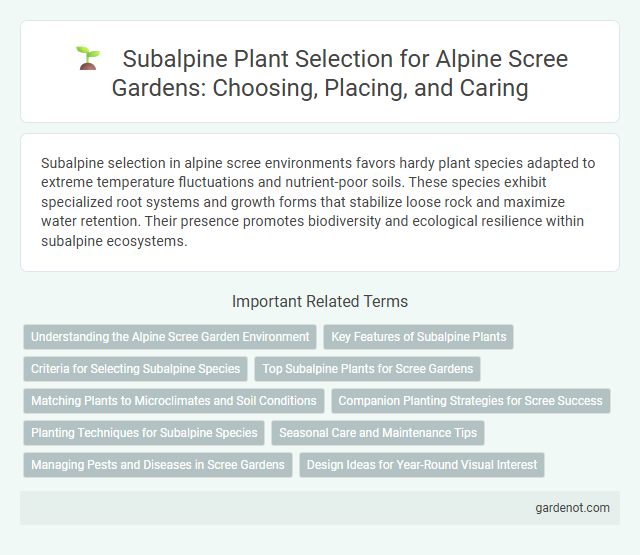Subalpine selection in alpine scree environments favors hardy plant species adapted to extreme temperature fluctuations and nutrient-poor soils. These species exhibit specialized root systems and growth forms that stabilize loose rock and maximize water retention. Their presence promotes biodiversity and ecological resilience within subalpine ecosystems.
Understanding the Alpine Scree Garden Environment
Subalpine selection in alpine scree gardens emphasizes plant species adapted to harsh conditions such as rocky, well-drained soils and fluctuating temperatures. Key species include Saxifraga, Gentiana, and Androsace, which exhibit drought tolerance and cold resistance to thrive in these microhabitats. Understanding the scree's gravelly substrate and snowmelt-driven moisture regime is critical for replicating natural growth patterns in cultivated alpine gardens.
Key Features of Subalpine Plants
Subalpine plants in alpine scree environments exhibit adaptations such as low-growing forms, deep root systems, and hairy leaves to minimize water loss and withstand harsh winds. Their ability to survive in nutrient-poor, rocky soils is supported by symbiotic relationships with mycorrhizal fungi, enhancing nutrient uptake. These key features enable subalpine vegetation to thrive in cold temperatures and short growing seasons characteristic of alpine scree zones.
Criteria for Selecting Subalpine Species
Criteria for selecting subalpine species in alpine scree environments emphasize adaptability to harsh climatic conditions, including tolerance to low temperatures, strong winds, and nutrient-poor soils. Species must exhibit deep root systems for soil stabilization and efficient water uptake in rocky substrates. Genetic diversity and resilience to seasonal snow cover and freeze-thaw cycles are critical factors in ensuring long-term survival and ecosystem stability.
Top Subalpine Plants for Scree Gardens
Top subalpine plants for scree gardens include Sedum species, Saxifraga, and Alchemilla, which thrive in well-drained, rocky soils. These hardy perennials exhibit drought tolerance and compact growth, ideal for mimicking natural alpine scree conditions. Their vibrant blooms and textured foliage enhance biodiversity while stabilizing loose scree substrate.
Matching Plants to Microclimates and Soil Conditions
Subalpine plants thriving on alpine scree exhibit specialized adaptations that match microclimates characterized by cold temperatures, intense sunlight, and variable moisture levels. Selecting species such as alpine saxifrage or dwarf willow ensures compatibility with rocky, well-drained, acidic to neutral soils commonly found in scree environments. This precise alignment between plant traits and soil and microclimatic conditions enhances survival, growth, and ecosystem stability on challenging subalpine scree slopes.
Companion Planting Strategies for Scree Success
Subalpine scree environments benefit from carefully selected companion planting strategies that enhance soil stability and microclimate regulation. Choosing species such as Saxifraga and Sedum creates symbiotic relationships that improve moisture retention and nutrient exchange in rocky substrates. These plant pairings increase resilience to harsh conditions, promoting sustainable growth and biodiversity in alpine scree landscapes.
Planting Techniques for Subalpine Species
Effective planting techniques for subalpine species in alpine scree environments emphasize careful site preparation to mimic natural soil conditions with well-drained, rocky substrates. Utilizing native subalpine plants such as Dryas octopetala and Saxifraga oppositifolia enhances ecological stability and promotes root establishment in unstable scree. Employing stone mounds or rock crevice planting supports moisture retention and protects seedlings from wind desiccation, crucial for survival in harsh subalpine climates.
Seasonal Care and Maintenance Tips
Subalpine scree ecosystems require seasonal care to manage soil erosion and support native plant growth, particularly during spring thaw and autumn leaf fall. Regular monitoring of drainage patterns and timely removal of invasive species help maintain the stability and biodiversity of scree slopes. Applying mulch and using protective barriers can conserve moisture and reduce temperature fluctuations critical for alpine flora survival.
Managing Pests and Diseases in Scree Gardens
Managing pests and diseases in subalpine scree gardens requires careful monitoring of common threats such as aphids, slugs, and fungal infections. Employing integrated pest management techniques, including biological controls and selective organic treatments, helps preserve the delicate alpine plant community. Maintaining optimal soil drainage and air circulation reduces disease prevalence, ensuring a healthy scree ecosystem.
Design Ideas for Year-Round Visual Interest
Subalpine scree gardens thrive with carefully selected alpine plants like Saxifraga and Sedum that provide texture and color throughout the seasons. Incorporate evergreens such as dwarf conifers alongside seasonal bloomers to maintain visual interest in winter and summer months. Integrating diverse rock sizes and strategic layering enhances naturalistic appeal while supporting plant health in varied weather conditions.
Subalpine selection Infographic

 gardenot.com
gardenot.com